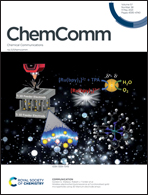自组装荧光探针的分类及其在癌症诊断中的应用
IF 4.3
2区 化学
Q2 CHEMISTRY, MULTIDISCIPLINARY
引用次数: 0
摘要
小分子荧光探针具有高灵敏度、高选择性、实时监测能力、无破坏性和多功能性等特点,是生物科学研究中不可或缺的有力工具。自组装荧光探针是一种新型材料,它能将荧光染料与特定分子自发组装成纳米级结构。与普通小分子荧光探针相比,自组装荧光探针在检测方面具有更高的稳定性、选择性、灵敏度和时间稳定性。近年来,癌症的发病率和死亡率逐年上升,给人类的生命安全带来了巨大挑战,而核磁共振、超声诊断、X射线断层扫描等传统诊断方法耗时长、分辨率低,手术切除时无法准确分辨正常组织和癌组织的界限,导致术后复发的可能。荧光探针可以快速有效地诊断和标记肿瘤癌细胞,对癌症的发现和治疗具有重要意义。本文综述了自组装荧光探针的分类(分子自组装荧光探针、纳米材料自组装荧光探针和生物大分子自组装荧光探针),通过对肿瘤微环境中含量异常的酶、活性物质和低pH值的特异性识别和监测,对癌症肿瘤组织的成像工作进行识别,以及目前自组装荧光探针面临的问题,希望能给读者带来更多启发。本文章由计算机程序翻译,如有差异,请以英文原文为准。
Classification of self-assembled fluorescent probes and their application in cancer diagnosis
The high sensitivity, high selectivity, real-time monitoring capability, non-destructiveness, and versatility of small molecule fluorescent probes make them indispensable and powerful tools in bioscience research. Self-assembling fluorescent probes are a novel type of material that spontaneously assembles fluorescent dyes with specific molecules into nanoscale structures. Compared with ordinary small molecule fluorescent probes, self-assembled fluorescent probes have higher stability, selectivity, sensitivity, and temporal stability in detection. In recent years, the incidence and mortality of cancer have increased year by year, which has brought great challenges to the safety of human life, and traditional diagnostic methods such as nuclear magnetic resonance, ultrasound diagnosis, X-ray tomography, etc., are time-consuming and have low resolution, and the boundary between normal tissue and cancer tissue cannot be accurately distinguished during surgical resection, resulting in the possibility of recurrence after surgery. Fluorescent probes can quickly and efficiently diagnose and label tumor cancer cells, which is of great significance for cancer discovery and treatment. In this paper, we review the classification of self-assembled fluorescent probes (molecular self-assembled fluorescent probes, nanomaterial self-assembled fluorescent probes and biological macromolecule self-assembled fluorescent probes), which are used to identify the work of imaging cancer tumor tissues and the current problems faced by self-assembled fluorescent probes through the specific identification and monitoring of enzymes with abnormal contents, active substances and low pH in the tumor microenvironment, hoping to give readers more inspiration.
求助全文
通过发布文献求助,成功后即可免费获取论文全文。
去求助
来源期刊

Chemical Communications
化学-化学综合
CiteScore
8.60
自引率
4.10%
发文量
2705
审稿时长
1.4 months
期刊介绍:
ChemComm (Chemical Communications) is renowned as the fastest publisher of articles providing information on new avenues of research, drawn from all the world''s major areas of chemical research.
 求助内容:
求助内容: 应助结果提醒方式:
应助结果提醒方式:


